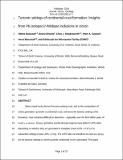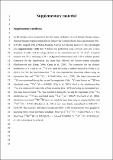Files in this item
Tectonic settings of continental crust formation : insights from Pb isotopes in feldspar inclusions in zircon
Item metadata
| dc.contributor.author | Delavault, Hélène | |
| dc.contributor.author | Dhuime, Bruno | |
| dc.contributor.author | Hawkesworth, Chris J. | |
| dc.contributor.author | Cawood, Peter A. | |
| dc.contributor.author | Marschall, Horst | |
| dc.contributor.author | the Edinburgh Ion Microprobe Facility | |
| dc.date.accessioned | 2017-08-17T23:33:10Z | |
| dc.date.available | 2017-08-17T23:33:10Z | |
| dc.date.issued | 2016-10-01 | |
| dc.identifier | 247264858 | |
| dc.identifier | 1657aa71-e40e-4e1a-a990-c652d0951dbb | |
| dc.identifier | 84991259397 | |
| dc.identifier | 000384307200010 | |
| dc.identifier.citation | Delavault , H , Dhuime , B , Hawkesworth , C J , Cawood , P A , Marschall , H & the Edinburgh Ion Microprobe Facility 2016 , ' Tectonic settings of continental crust formation : insights from Pb isotopes in feldspar inclusions in zircon ' , Geology , vol. 44 , no. 10 , pp. 819-822 . https://doi.org/10.1130/G38117.1 | en |
| dc.identifier.issn | 0091-7613 | |
| dc.identifier.other | RIS: urn:4CAF58F2E5E55ED2B9C42BF4E8AF8875 | |
| dc.identifier.uri | https://hdl.handle.net/10023/11501 | |
| dc.description | This work was supported by the Natural Environment Research Council (NERC grants NE/J021822/1 and NE/K008862/1) and by the Leverhulme Trust (grant RPG-2015–422). | en |
| dc.description.abstract | Most crustal rocks derive from preexisting crust, and so the composition of newly generated (juvenile) continental crust, and hence the tectonic settings of its formation, have remained difficult to determine, especially for the first billion years of Earth’s evolution. Modern primitive mantle–derived magmas have distinct U/Pb ratios, depending on whether they are generated in intraplate (mean U/Pb = 0.37) or in subduction settings (mean U/Pb = 0.10). The U/Pb ratio can therefore be used as a proxy for the tectonic settings in which juvenile continental crust is generated. This paper presents a new way to see back to the U/Pb ratios of juvenile continental crust that formed hundreds to thousands of millions of years ago, based on ion probe analysis of Pb isotopes in alkali feldspar and plagioclase inclusions within well-dated zircons. Pb isotope data are used to calculate the time-integrated U/Pb ratios (i.e., 238U/204Pb = µ) for the period between the Hf model age and the U-Pb crystallization age of the zircons. These time-integrated ratios reflect the composition of the juvenile continental crust at the time it was extracted from the mantle, and so they can be used as a proxy for the tectonic setting of formation of that crust. Two test samples with Proterozoic Hf model ages and Paleozoic crystallization ages have feldspar inclusions with measured Pb isotope ratios that overlap within analytical error for each sample. Sample Z7.3.1 from Antarctica has Pb isotope ratios (mean 206Pb/204Pb = 16.88 ± 0.08, 1σ) that indicate it was derived from source rocks with low U/Pb ratios (∼0.11), similar to those found in subduction-related settings. Sample Temora 2 from Australia has more radiogenic Pb isotope ratios (mean 206Pb/204Pb = 19.11 ± 0.23, 1σ) indicative of a source with higher U/Pb ratios (∼0.36), similar to magmas generated in intraplate settings. Analysis of detrital populations with a range of Hf model ages (e.g., Hadean to Phanerozoic), and for which zircons and their inclusions represent the only archive of their parent magmas, should ultimately open new avenues to our understanding of the formation and the evolution of the continental crust through time. | |
| dc.format.extent | 4 | |
| dc.format.extent | 1176259 | |
| dc.format.extent | 9710737 | |
| dc.language.iso | eng | |
| dc.relation.ispartof | Geology | en |
| dc.subject | GE Environmental Sciences | en |
| dc.subject | NDAS | en |
| dc.subject.lcc | GE | en |
| dc.title | Tectonic settings of continental crust formation : insights from Pb isotopes in feldspar inclusions in zircon | en |
| dc.type | Journal article | en |
| dc.contributor.sponsor | NERC | en |
| dc.contributor.institution | University of St Andrews. School of Geography and Geosciences | en |
| dc.contributor.institution | University of St Andrews. Earth and Environmental Sciences | en |
| dc.contributor.institution | University of St Andrews. Scottish Oceans Institute | en |
| dc.contributor.institution | University of St Andrews. St Andrews Isotope Geochemistry | en |
| dc.identifier.doi | 10.1130/G38117.1 | |
| dc.description.status | Peer reviewed | en |
| dc.date.embargoedUntil | 2017-08-17 | |
| dc.identifier.grantnumber | NE/J021822/1 | en |
This item appears in the following Collection(s)
Items in the St Andrews Research Repository are protected by copyright, with all rights reserved, unless otherwise indicated.


